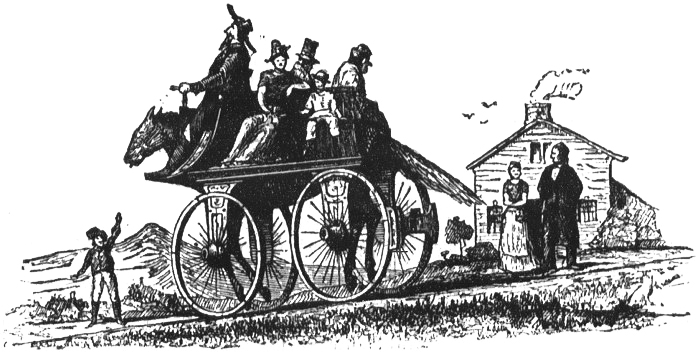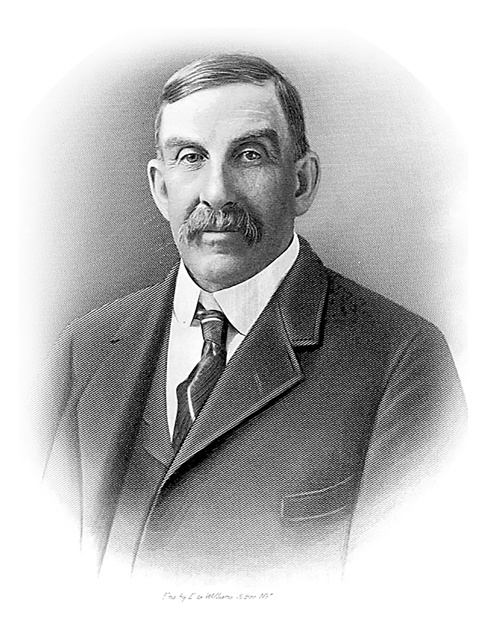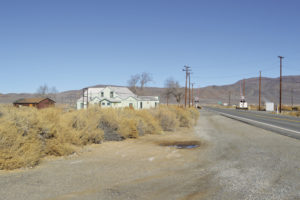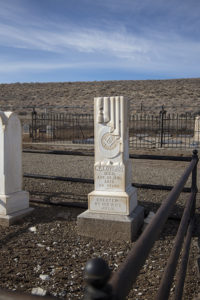Fantastical Fallacies of the Notorious ‘Mangler’
March – April 2019
Rival newspapers dueled in print, as the editors experienced identity crises.
BY ERIC CACHINERO

A sinister sabotage was recorded some time during 1889-1891, documented by editor E. P. Lovejoy of the Nevada newspaper “Wabuska Mangler” and reprinted as a guest editorial in an issue of the Carson City paper the “Morning Appeal:”
“The ‘Wabuska Mangler’ of Friday says: ‘Last week as the ‘Mangler’ was going to press, Sol Noel’s Holstein bull came charging into the office and demolished the forms so that we were unable to get the issue out today. We are well aware of the fact that the ‘Mangler’ in this section is a great annoyance to a good many men here who would like to run politics to suit themselves. We know for a fact that for some months past, Sol Noel and a lot of his conferees have been training the bull to charge into print shops. They rigged up an old cider press and fixed a lever on it so as to represent the ‘Mangler’ press and a man would stand on the side and make motions as if running an ink roller over the forms. They would then flaunt a red flag in the bull’s face and let him charge on the machine and knock it over. He would then be fed real hay as a reward for his success in demolishing an educational engine. They got the bull well in train and then sent it charging into our office with the above result. He went home with his hide filled with No. 8 shot and if any of the gang come here again they will be treated to something a little heavier. We will continue to publish the ‘Mangler’ and show up political iniquity whenever it can be found. We will begin suit against Noel in the justice court tomorrow for back subscription and damages.’”
Many times during the next several years, the “Mangler” would be ailed by similar oddities, which often times were reprinted in the “Appeal.” Maybe it was karma at work. Lovejoy was, in fact, seen as a dastardly, vile skunk, and his wicked “Wabuska Mangler” was considered a black mark on the face of the west. Even prestigious Nevada journalist Samuel Post Davis—then editor of the “Appeal”—penned that the “Mangler” was a “wicked little sheet,” and that its editor, Lovejoy, was a “disgrace to journalism.” Another St. Louis journalist wrote: “Of all the liars on the face of the Earth, we believe the Nevada newspaper liar is the most prodigious outside of Missouri.”
Davis defended his paper from Lovejoy on countless occasions, stating that the “old liar” has been “slinging mud at the ‘Appeal’ for some years.” Nonetheless, Davis couldn’t resist publishing the sometimes fantastical fallacies of the notorious “Mangler.”
But here’s the peculiar thing: Samuel Post Davis was E. P. Lovejoy, and the “Wabuska Mangler” didn’t actually exist.
TWO FACE

Tall tales in journalism were relatively common on The Comstock and surrounding regions during the late 1800s. Perhaps most famous for publishing these exaggerated truths and outright lies is Comstock newspaperman William Wright, who wrote under the penname Dan DeQuille. DeQuille dreamed up some famous fibs over the years, including a widely circulated story of an inventor who created a water suit to keep cool in the desert, only to be found frozen to death in the hot sun with an icicle hanging low from his nose.
The “Wabuska Mangler” was Davis’ contribution to the fun. Davis, along with other famous Nevada newspapermen of the time—including Mark Twain, Alfred R. Doten, and Fred H. Hart—loosely formed a literary movement called the Sagebrush School. The Sagebrush School was renowned for its often-exaggerated storytelling, and these journalists were, as a quote sometimes attributed to Twain puts it, known for “never let[ting] truth get in the way of a good story.”
Because a lull in readership was becoming a worry at his “Appeal,” Davis did as any self-respecting editor would: he conjured up a fictitious newspaper and lied to his readers, and they ate it up. Everyone loves a juicy story, and Davis painted the “Mangler” and its editor as the juiciest. Another one of the famous “Mangler” articles found its way into the “Appeal” and an issue of the California newspaper “Pacific Rural Press:”
“Mr. Torreyson, the blacksmith, of this city, is noted for his kindness towards animals. He has just built a road cart, now on exhibition at his blacksmith shop, which is destined to revolutionize traveling by road and to materially lighten the labors of that noble animal, the horse. The idea is to occasionally give the horse a chance to ride in the cart as the driver. The idea was first suggested to Mr. Torreyson by seeing a turtle move along the road carrying his shell with him. The vehicle made by Mr. Torreyson has four high wheels and the place between them arched, so that the horse is hitched under the wagon between the wheels, his head projecting a little beyond the front wheels and his tail just barely clearing the hind wheels. The driver sits just over the horse’s neck and the others in the wagon face outward on each side. The horse is so fastened that the pulling is distributed over his body and does not all come of his neck and shoulders. In this position he is greatly protected from the sun and storm and thereby enabled to make long journeys with less fatigue.
But the principal part of the invention lies in a belly-band about four feet wide passing under the horse. When you reach the top of a long hill, down which a horse would have to go slowly as he held back the load, you simply turn a crank and it lifts the horse off its feet several inches from the ground and the vehicle then runs down the hill of its own momentum. It is provided with a steering apparatus and a brake, that the vehicle may be steered and its velocity regulated.
Several times during the day the tired horse has a chance to ride and is very much rested. Also when the horse attempts to run away you wind up the crank and he is lifted off the ground perfectly hopeless.”
Although the “Mangler” was a dreamt-up newspaper, Edward Payson Lovejoy was not a dreamt-up editor.

A STRANGE FIXATION
History maintains that Davis and Lovejoy met by chance while attending the Lyon County Fair, where Davis was showing some of his prize cattle. The two got to know each other pretty well. Though they weren’t known to be friends necessarily, Davis’ adaptation of Lovejoy as the “Mangler’s” editor was tongue in cheek and not malicious.
Edward Lovejoy was actually a somewhat famous name in the history books. He was the only child of Elijah P. Lovejoy, an abolitionist newspaper editor shot dead by a pro-slavery mob. Lovejoy Sr. was a martyr and is remembered as a hero in journalism, due to his anti-slavery views and his sacrifice defending those views. When a Missouri attorney almost killed one of his slaves by beating him nearly to death, Lovejoy Sr. penned his opposition. This kicked off a series of angry mobs, who forcefully entered Lovejoy Sr.’s place of work and, on several occasions, dragged his printing press and pushed it into the Mississippi River. Lovejoy Sr. was killed while defending one of his printing presses.
 Lovejoy Jr. was only 1 year old when his father died. As he grew up, he bounced around many different places in the U.S. before ending up as a laborer for the Carson and Colorado railroad in Wabuska in 1880.
Lovejoy Jr. was only 1 year old when his father died. As he grew up, he bounced around many different places in the U.S. before ending up as a laborer for the Carson and Colorado railroad in Wabuska in 1880.
Wabuska—located in Lyon County at the northern end of Mason Valley—was barely a blip on the radar at the time. When the railroad began operations in 1881, Lovejoy was named the Wabuska agent. He built a house there before eventually opening up a general store, bar, and hotel, as well as a ranch. He enjoyed a comfortable and mostly quiet life in Wabuska, save for the things Davis dreamt up about him.
Lovejoy died suddenly in 1891, and with him, the “Mangler” so too faded from the pages of the “Appeal,” probably a sign of respect offered by Davis. Some sources claim that upon learning of Lovejoy’s death, Davis penned a column claiming thatLovejoy had contracted a serious illness, closed up shop at the “Wabuska Mangler,” and headed east. The final column came shortly after, claiming that Lovejoy had faked his illness and had actually took off in the middle of the night to avoid a grand jury indictment.
FROM THE PAGE TO THE GRAVE
Lovejoy is buried in Dayton, though thanks to Davis, his name will remain immortalized probably long after his grave is forgotten. He was a real man in a real place, though unspectacular as the man and place may have been, they will forever more remain a chapter in the sometimes whimsical and unorthodox arena that is Nevada journalism. So take the next article written by a Nevada journalist with a grain of salt. We really do never let truth get in the way of a good story.

